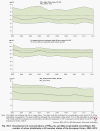VIII. THE EUROPEAN CONTEXT
Despite a significant improvement in the last decades, Europe is still far from achieving a level of air quality that would not pose unacceptable risks to humans and the environment. Air pollution in Europe is one of the most hazardous environmental factors. It is causing premature deaths, increasing the prevalence of a wide spectrum of diseases, and damaging vegetation and whole ecosystems, leading to loss of biological diversity. All this also brings considerable economic losses.
From the perspective of damage to human health, the most problematic are the current concentrations of particulate matter (PM) and ground-level ozone (O3), followed by benzo[a]pyrene and nitrogen dioxide (NO2). As far as damage to ecosystems is concerned, the most harmful pollutants are ground-level ozone (O3), ammonia (NH3) and nitrogen oxides (NOX). Polluted air causes serious health problems especially to inhabitants of towns and cities. The level of O3 concentrations to which the urban population is exposed has been more or less stable since 2004, with certain annual variations, whereas the exposure of urban dwellers to concentrations of PM10 and especially NO2 has decreased (Fig. VIII.1). Increased attention is being paid to concentrations of benzo[a]pyrene because its emissions rose by 21 % in the period 2003–2012, mainly due to the 24 % surge in emissions from household combustion (Fig. VIII.2). In EU member states, over the three-year period of 2010–2012, 21–30 % of urban inhabitants were exposed to limit-exceeding 24-hour concentrations of PM10, 10–14 % to over-limit annual concentrations of PM2.5, 24–28 % to over-limit annual concentrations of benzo[a]pyrene, 14–17 % to concentrations of O3 higher than the limit value and 8–13 % to over-limit annual concentrations of NO2. The proportion of the population exposed to concentrations exceeding the WHO guideline values was even higher, e.g. by 91–93 % for PM2.5, by 85–89 % for benzo[a]pyrene, by 95–98 % for O3 and strikingly by 36–54 % for SO2. Estimates of health impacts of polluted air show that long-term exposure to fine particles (PM2.5) caused roughly 458,000 premature deaths in 2011. The impact of short-term exposure of Europeans to O3 in 2011 has been estimated to cause about 17,400 premature deaths (EEA 2014c).
The most exposed to limit-exceeding concentrations of suspended particles and benzo[a]pyrene are inhabitants of Central and Eastern Europe, including the Balkans. The Po Valley in northern Italy is also among the most polluted areas (Figs. VIII.3 and VIII.4). Limit concentrations of NO2 are exceeded especially in places affected by transportation (Fig. VIII.5). Above-the-limit concentrations presumably also occur in countries that monitor these pollutants only at a limited number of localities or not at all as well as those that do not provide these data to the European database (AirBase 2015). Primary pollutants, originating from local and regional sources of emissions, are accompanied by pollution of the air by secondary aerosols (see Chapter IV.1.4) and ozone. Concentrations of ozone, due to the mechanism of its origin (see Chapter IV.4.3), range from low values in Northern Europe to the highest concentrations especially in countries around the Mediterranean Sea (Fig. VIII.6), where ozone concentrations are high especially during the summer period (EEA 2015).
The level of air pollution strongly varies in different parts of the Czech Republic. On the one hand, there are some very slightly polluted areas in which air quality is similar to clean, continuously inhabited regions of Europe, where concentrations of pollutants are far from exceeding limit values. The lowest concentrations, e.g. of PM10 and PM2.5, measured in the Czech Republic are nevertheless comparable to concentrations in many European cities. In other words, background concentrations in the Czech Republic are higher than in the least burdened areas of Europe. On the other hand, the O/K/F-M agglomeration, together with the adjacent area of Poland, is among the most polluted regions of Europe, both in the size of the area affected and the concentrations reached (see Chapter IV). Transport of pollutants between the Czech Republic and neighbouring countries is the most intensive in the region of Silesia (for details see Chapter V.3 and Blažek et al. 2013). Polluted air, of course, travels across the state border also in other regions, but mutual cross-border effects are much smaller, and its quantification or estimated influence is usually unavailable. Besides the region of Silesia, the contributions of different sources to the level of air pollution are described in more detail only for the Czech-Slovak border region of the Moravia-Silesian and Žilina region (VŠB-TU Ostrava 2014). A separate problem is long-distance transpoert of pollutants across the whole continent and beyond (EMEP 2015).

Fig. VIII.1 Development of concentrations of PM10, O3 and NO2 recalculated according to the number of urban inhabitants in 28
member states of the European Union, 2003–2012

Fig. VIII.2 Development of emissions in 28 member states of the
European Union, 2003–2012

Fig. VIII.3 Annual average concentration of PM2.5 in Europe,
2012

Fig. VIII.4 Annual average concentration of benzo[a]pyrene in Europe, 2012

Fig. VIII.5 Annual average concentration of NO2 in Europe, 2012

Fig. VIII.6 The 26th highest maximum daily 8-hour average of O3 concentration in Europe, 2012